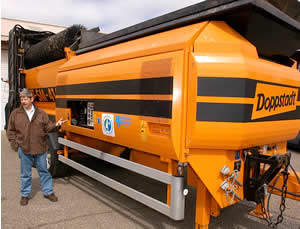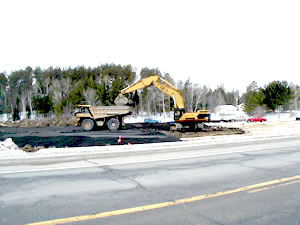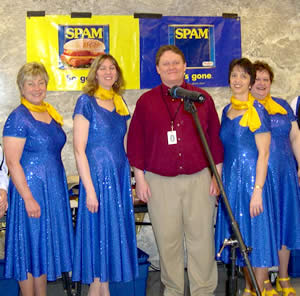 |
 |
|
 |
Road construction season begins |
 |
 |
 |
|
"Building more, building faster and moving better really
captures the spirit of what taxpayers will see over the next six years,"
Lt. Gov./ Commissioner Carol Molnau said at the April 6 news conference
that kicked off the 2004 construction season. In the background is the
I-494/Wakota Bridge. By David Gonzalez
|
Mn/DOT will start or carry over 190 construction projects designed to relieve
congestion, improve interregional corridors and enhance safety on the state's
12,000-mile trunk highway system, Lt. Gov./Commissioner Carol Molnau announced
last week.
Against the backdrop of the I-494/Wakota Bridge project in the Twin Cities,
Molnau and other Mn/DOT leaders April 6 announced the beginning of the state's
2004 road construction season. Combined, the projects represent an investment
of more than a billion dollars.
To coincide with the construction kickoff, Gov. Tim Pawlenty
also declared April 4-10 as"Transportation Awareness Week."
"The volume of the work on our roads represents our efforts to improve the
statewide transportation system," Molnau said. "Building more, building faster
and moving better really captures the spirit of what taxpayers will see over
the next six years."
Mn/DOT will begin moving forward on the 12 major highway construction projects
advanced under the Pawlenty-Molnau 2003 Transportation Finance Bill, which is
the largest transportation investment in state history. This funding allows
Mn/DOT to advance the projects by an average of five years per project, Molnau
said.
According to Bob Winter, District Operations Division director, the funding
package provides about $900 million more than the state's current construction
program and includes funds for transit-related highway work and safety and preservation
projects. Bond-accelerated projects under way this season include:
- New four-lane alignment of Hwy 14 from Janesville to Waseca
- Reconstruction of the I-694/I-35E interchange in the Twin Cities
- Construction of an additional lane on I-494 from Hwy 212/5 to Hwy 55
- Reconstruction of Pioneer Trail and Anderson Lakes Parkway interchanges
on Hwy 169
Mn/DOT is also working on several other new and continuing projects, including:
- Renovation of Hwy 38 (Edge of the Wilderness National Scenic Byway) in
Itasca County
- Construction of a new interchange at Hwy 53 and Hwy 169 north of Virginia
- Reconstruction of the Hwy 169 Causeway across Pokegama Lake near Grand
Rapids
- Replacement of the Main Avenue Bridge (Hwy 10) in Fargo-Moorhead
- Reconstruction of Hwy 23 in Stearns County
- Reconstruction of Hwy 47 in Isanti and Kanabec counties
- Reconstruction and third-lane addition on I-94 between Maple Grove and
Brooklyn Center
- Reconstruction of the I-494 and Hwy 61 interchange, including the replacement
of the Wakota Bridge over the Mississippi River in the Twin Cities
- Reconstruction of Hwy 14 in New Ulm
- Reconstruction of Hwy 23 through Spicer
- Reconstruction of Hwy 52 through Rochester
The start of the construction season also signals the need for drivers to use
extra caution because the number of highway work zones will grow rapidly with
the onset of warmer weather.
Mn/DOT urges motorists to focus fully on their driving, especially in work
zones. That means, Molnau said, observing work zone speed limits and staying
alert for workers and equipment in or near work zones.
"The department will use public service announcements, billboards, highway
signs and other measures to warn drivers about work zone safety, but motorists
carry their share of responsibility for safe driving in work zones as well,"
she said.
To help travelers plan their trips to avoid major highway projects, Mn/DOT
urges drivers to use its new Traveler Information System by dialing 5-1-1 or
via the Web site at www.511mn.org/.
For more information on statewide construction, including maps, visit www.dot.state.mn.us/construction.
By Jeanne Aamodt
|
back

|
 |
Fallen workers to be honored April 28 |
 |
 |
Mn/DOT’s Worker Memorial Day commemoration takes place statewide on Wednesday,
April 28.
The day honors employees who were injured or killed performing their jobs as
highway maintenance and construction workers. Twenty-eight Mn/DOT employees
and eight State Patrol officers have been killed in work-related crashes.
At 2 p.m., there will be a brief recorded message from Lt. Gov./Commissioner
Carol Molnau, who will be attending events in St. Cloud/District 3, followed
by a moment of silence.
In addition, the governor is expected to issue a proclamation declaring April
28, 2004 as Worker Memorial Day.
As in past years, employees are asked to wear an orange ribbon pin on April
28 to honor their fallen co-workers. A limited number of extra pins is available
from district public affairs coordinators and office managers.
Bob Winter, District Operations Division director, will host the event held
near the Worker Memorial Monument in Central Office. Guest speakers include
representatives from the Department of Public Safety, Department of Labor and
Industry, the Minnesota State Patrol and AFSCME Council 6.
Also speaking at the CO event will be Terry Schmitt, transportation generalist,
Rochester/District 6, who will describe the time he was seriously injured when
a semi-trailer truck crashed into his snowplow in January 1998.
David Smith, Metro District transportation generalist, will be honored for
his efforts initiating a Worker Memorial Day at Mn/DOT. Smith knows firsthand
the dangers transportation workers face: he has experienced two work-related
accidents in his 32-year state career.
|
back

|
 |
Spring cleaning: Metro’s ‘super screener’ cleans road sand collected after each
winter |
 |
 |
 |
|
Norm Ashfeld, a Metro District maintenance superintendent,
explains the operation of the Droppstadt trommel screener. Photos by
David Gonzalez |
Metro’s powerful sand screener makes noise and collects dirt, but any similarity
to the average vacuum cleaner ends right there. For the second year, the Metro
District will use its trommel screener to separate tons of tire particles, bits
of metal, garbage and other debris that it collects while sweeping up winter
sand from about 5,200 miles of highway.
The district’s maintenance crews pick up a lot more than they put down.
Norm Ashfeld, a district maintenance superintendent, said Metro applies about
3,000 tons of sand each winter, but collects about 12,000 tons of sand and other
material each spring and summer.
If left untreated, the district would have to send all of the collected material
to a landfill. Screening, however, separates the metals and other debris and
leaves clean, reusable sand.
After they’re collected, the sweepings are run through the screener, which
uses a cylindrical, revolving sieve to separate the materials. The process creates
piles of metal that are recycled, debris that must be taken to a landfill, and
thousands of tons of sand the district can reuse as clean fill for construction
projects.
 |
|
The screener uses a revolving, cylindrical sieve to
separate debris, metals and clean sand.
|
The screener also can be used to sift black dirt for construction projects.
The screener is portable; it is moved to four or five different sites in the
district where the sand sweepings are deposited and then processed.
Last year, Ashfeld said, using the screener enabled the district to save about
$800,000 in landfill disposal fees by cutting the amount sent to landfills from
about 12,000 tons to a little more than 600 tons. The cost savings more than
paid for the screener during its first year of use, he said.
Removing the sand is important, Ashfeld said, because it can clog drains, increase
turbidity in lakes and rivers that harms fish and other wildlife, and contribute
to erosion and other environmental problems.
"The screener helps us in several ways," Ashfeld said. "It cuts
costs, reduces demand on landfill space and removes tire debris, metal and other
pollutants from the environment."
By Craig Wilkins
|
back

|
 |
Recycling taconite tailings turns byproduct into valuable material for building
roads |
 |
 |
 |
|
A 70-ton capacity mine truck hauls taconite tailings
to the Hwy 53/Hwy 169 interchange project at Virginia. Photo by Kevin
Adolphs |
This racing season, cars and motorcycles speeding around the Brainerd International
Raceway will get a little extra traction from taconite tailings used to pave
the track’s asphalt surface.
While racers roar around the course, construction crews 180 miles away will
methodically recycle about one million tons of the tailings—the waste product
derived from turning the iron-rich mineral into iron ore—to build a new Hwy
53/Hwy 169 interchange at Virginia.
The Virginia project, which started in March, marks the department’s most substantial
use of the material since the 1960s, said Kevin Adolphs, resident engineer at
District 1’s Virginia construction office.
Other Mn/DOT projects that have incorporated tailings include rebuilding Hwy
71 near Northome, Hwy 2 between Floodwood and Duluth and the recent Hwy 53 (Piedmont
Avenue) project in Duluth.
Mn/DOT’s use of the tailings has increased in recent years, Adolphs said, reaching
127,000 tons in 2002.
Adolphs said the tailings can be used in bituminous mixtures such as the track
at BIR and to replace standard aggregate rock for the wearing surface in Superpave
asphalt projects. However, Mn/DOT’s most common use for the tailings is for
clean fill.
Adolphs said tailings work as well as other minerals and have some advantages.
He said, for example, that the tailings are "clean," that is, well-defined
crystals that shed moisture easily and dry quickly after getting wet.
The tailings, Adolphs notes, are from the western side of the Iron Range. State
law prohibits the use of tailings from the east side of the Range, which were
found to contain an asbestos-like material. The tailings were the focus of a
landmark 1970s era court case in which the Reserve Mining Company was prohibited
from dumping the tailings into Lake Superior at its facilities near Silver Bay.
Cost for the taconite tailings generally equals that of standard aggregate
rock—about 50 cents to one dollar per ton. The cost of hauling the tailings
from mining sites in the Iron Range is the most limiting factor in its use,
Adolphs said.
He said, however, long-distance hauling is not an issue for this project.
"There’s the MinnTac mine in Virginia about a mile from the site, so the
contractor built a special haul road to transport the tailings right to the
project site," Adolphs said.
By Craig Wilkins
|
back

|
 |
Cutting edge training, information offered at Spring Maintenance Expo |
 |
 |
Reserve April 27 and 28 in your calendars for the 2004 Minnesota Spring Maintenance
Training Expo at the St. Cloud Civic Center. Township, city, county, and state
maintenance operators and supervisors, plus transportation and research implementation
staff, are encouraged to attend.
This year’s two-day event focuses on spring and summer roadway maintenance
issues and highlights the latest practices and technology in Minnesota maintenance
operations.
General session topics cover the Toward Zero Deaths program, the Twin Cities
light rail transit project and training opportunities. Concurrent session offerings
include chain saw safety, wildlife control, Minnesota truck regulations, erosion-control
training, pesticide application principles and truck-weight compliance basics.
"The Expo provides important educational opportunities to help maintenance
workers meet the challenges of their jobs," said Ken Nelson, Maintenance
Operations support specialist. Nelson said participants can receive 0.9 continuing
education units and "roads scholar"credits—0.5 for one-day and 1.0
for two-day attendance.
"Fifty-six vendors will display the latest innovations in equipment, products
and services," said Nelson. "And, there will chances to win valuable
door prizes—more than just a hat."
To register online, go to the University of Minnesota’s Expo Web site at www.mnltap.umn.edu/expo.
You can also register by mail (by April 21 to avoid a late fee) or in
person the day of the event. Contact Nelson at 651/282-5435 for more information.
The expo is sponsored by Minnesota Local Technical Assistance Program, Center
for Transportation Studies and the University of Minnesota in cooperation with
Minnesota Local Road Research Board, Mn/DOT, Minnesota Street Superintendents
Association and Minnesota Public Works Association.
By Donna Lindberg
|
back

|
 |
IronMail: Getting tough on spam |
 |
 |
 |
More than one kind of spam was represented recently at the Central
Office. Pictured is Bob Bennett, Office of Information Technology, Mn/DOT's
unofficial "anti-spam king," who leads the group responsible
for reducing electronic junk mail within the department. The women are
part of the Spamettes, singers celebrating the wonders of the canned
meat product during "SPAM Day at the Capitol" on March 31.
By Jon Soder
|
If you’re tired of wading through unsolicited mortgage rate offers, prescription
drug advertisements and other electronic junk mail, then Mn/DOT’s new anti-spam
software—IronMail—may bring relief to you.
Since its implementation in March, IronMail has filtered an average of 7,000
e-mail messages per day, according to Bob Bennett, Office of Information Technology.
Most of these captured e-mails fall under the category of spam, which includes
bulk commercial mail, "scam" mail and mail with inappropriate content.
"Spam is not just a nuisance," he said. "It also is a security
issue because these unwanted e-mails can contain computer viruses."
About 400 Mn/DOT employees currently are using IronMail, Bennett said, noting
that employees have the option of whether or not to subscribe (at no cost) to
the anti-spam service. Network Operations Center staff in Central Office administers
and monitors the IronMail service.
IronMail works with Mn/DOT’s other information technology to filter spam before
it enters the department’s e-mail system by identifying common characteristics
of spam (such as certain e-mail addresses and sexually explicit content) and
blocking these messages.
Bennett said that using IronMail will not completely eliminate spam, but it
will significantly reduce the amount employees receive. Although some legitimate
mail may get blocked in the process, IronMail allows employees to review and
release legitimate mail. NOC's target is to catch 90 percent of spam e-mail,
while limiting legitimate e-mail filtered to less than one percent, he said.
Follow this link (http://ihub.oit/standards/stdupdate19.pdf)
for more information about IronMail and for instructions in how to
have the service applied to your GroupWise account.
|
back

|
 |
Aviation Hall of Fame inducts Dan McDowell |
 |
 |
 |
|
Dan McDowell, Office of Aeronautics |
Correction (April 23, 2004): The Minnesota
Aviation Hall of Fame recognized Dan McDowell for his writing, which
appears in aviation-related publications. He was not inducted into the Hall
of Fame, as reported below. See the April 28, 2004 Mn/DOT Newsline for more
information.
Dan McDowell, senior aviation planner, Aeronautics, will join the ranks of
the state’s distinguished aviation leaders April 17 when he is inducted into
the Minnesota Aviation Hall of Fame.
McDowell was selected for his varied contributions to aviation—including writing
for aviation publications and his service with Mn/DOT ‘s Office of Aeronautics;
his service with the U.S. Air Force and the Minnesota Air National Guard and
his work as an assistant station manager with the former Ozark Air Lines.
McDowell’s work with Aeronautics began in 1990. His duties include planning,
serving as its public affairs coordinator and representing Mn/DOT to the state
and federal military aviation organizations.
Hall of Fame officials recognized those contributions and McDowell’s authoring
the Aeronautics Technical Bulletin since 1991 and writing for publications
such as Midwest Flyer and Minnesota Flyer. His work is often republished
in regional and national aviation publications.
The Aviation Hall of Fame was established in1988 to honor Minnesotans’ contributions
to aviation. Its honorees include aviators, inventors and leaders in the aviation
industry.
With this year’s inductees, the Hall of Fame will include 110 members.
For more information about the Hall of Fame, go to http://www.dot.state.mn.us/aero/aved/museum/MNpioneers.htm.
By Craig Wilkins
|
back

|
 |
Photographer David Gonzalez illustrates new road-building book for children |
 |
 |
 |
|
Photographer David Gonzalez. Photo by Pamela Gonzalez
|
A new book about road building for children now resides among a row of highly
technical journals in the Mn/DOT Library.
The basics of road building are well known to most Mn/DOT people, but a new
book for young children explains the process in simple sentences and photos.
Mn/DOT’s David Gonzalez, a photographer with Administrative Services, provided
many of the book’s pictures.
Gonzalez took photos of construction on Hwy 52 and other sites used in "From Rock
to Road," a book recently published by Lerner Publications in Minneapolis.
The photos include activities such as grading, paving and striping.
The book’s publisher gave copies to Gonzalez and the library to show its appreciation
for Mn/DOT’s role in the book’s creation. The new title is part of a series
of books for children.
Gonzalez’s work can also be seen on Mn/DOT’s iHUB front page, Mn/DOT Newsline
and other department electronic and print publications and at the new transportation
exhibit at the Minnesota History Center.
The book is available for loan from the Mn/DOT library.
By Craig Wilkins
|
back

|
 |
|
 |



